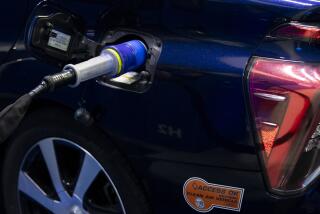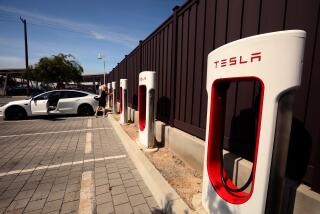Honda, Chevrolet give natural gas a push

- Share via
Natural gas is the neglected stepchild of the alternative fuel vehicles industry.
Used in some commercial truck fleets, municipal bus services and the occasional taxicab, the plentiful low-emissions fuel has never caught on in passenger cars — even though it sells for about half the equivalent of a gallon of gasoline in California.
Two automakers are making another run at selling compressed natural gas, or CNG, cars in the U.S., eyeing a market in commuters and efficiency-minded drivers.
Honda launched an updated version of its natural gas-fueled Civic this year — finally offering amenities such as heated leather seats and a six-speaker audio system in what was previously a spartan car — and Chevrolet is set to launch its dual-fuel Impala in a few months. The large sedan will run on either gasoline or natural gas.
Both cars are factory produced and have the same warranties as their gasoline-only counterparts. That should give consumers more confidence in the technology, the automakers said. It also prevents arguments over blame and responsibility if a problem crops up. That issue has troubled conversions of gasoline vehicles into natural gas autos, said Michael Jones, product manager for CNG vehicles at General Motors Co.
The two models will create competition among manufacturers of natural gas passenger cars, something the industry has not seen in a decade, said Todd Clements, who runs AltFuelPrices.com. The website tracks the location of CNG filling stations and prices.
Ford Motor Co. and Toyota Motor Corp. once made CNG passenger cars but dropped out of the market years ago. Chrysler offers a factory-produced CNG pickup truck. GM partners with a supplier to complete the build of its CNG pickup. Ford offers its F-150 truck prepped with special equipment that makes it easier to convert the pickup to run on natural gas.
“But if you want a passenger car you have a choice right now of a Civic or a Civic,” said Clements, who drives an older model CNG Civic.
It’s not that automakers don’t understand how to offer a compelling natural gas car. They sell many models in Europe, Clements said.
But auto companies don’t believe they can make money on CNG vehicles in the U.S., he said.
Ford officials say they have stayed out of the market because the cars are too expensive to build, there’s almost no consumer demand and they don’t believe they can produce natural gas cars that will meet American expectations for range and cargo space.
Another factor holding down natural gas car sales is the lack of support from environmental groups, which advocate more for other alternative fuel options. Lawmakers and regulators also have pushed other technologies — electric cars, plug-in hybrids and hydrogen fuel cell vehicles.
“Look at how many different electric vehicles there are now, and soon there will be at least three choices of fuel cell vehicles on the market, more than CNG cars,” Clements said.
Through the first half of this year, there have been only 254 new vehicle registrations for CNG autos, according to IHS Automotive. That compares with almost 47,000 registrations of electric cars and 46,000 registrations of plug-in hybrids.
This is happening even though natural gas vehicles can reduce smog-forming emissions of carbon monoxide 70% and produce 20% less greenhouse gas emissions than gasoline powered cars, according to the California Air Resources Board.
Nonetheless, environmentalists don’t view CNG as a solution to air pollution and greenhouse gas emissions.
“We look at the technologies you need to put on the road not today, but in 2050. To meet the greenhouse gas reduction goals by then you need electrification,” said Simon Mui, director of California vehicles and fuels for the Natural Resources Defense Council. “Unfortunately, CNG vehicles don’t get you there.”
Another challenge is that the pollution-fighting advantage enjoyed by natural gas vehicles is decreasing as the U.S. ramps up fuel economy and emission standards for gasoline and diesel vehicles, Mui said.
Still, Clements said Chevrolet’s decision to offer a CNG Impala would help make natural gas vehicles more viable.
“To have more than one choice will tell consumers there is something to this market,” he said.
Honda believes drivers will want a vehicle with greater range than an electric car; the updated Civic will travel 220 miles between fuel stops, compared with about 80 miles that a typical electric car can go on a full charge. But motorists still want access to the carpool lane and toll incentives that come with alternative fuel vehicles.
The new Civic version starts at $26,640, about $4,000 more than the comparable gasoline version. Adding in a navigation system and the leather seats pushes the price to $29,290 — nearly the cost of an entry-level luxury car. The navigation system is helpful because it can direct drivers to the nearest CNG station.
Honda charges more for the Civic CNG because several components require extra engineering, including the military-grade aluminum and carbon-fiber-wrapped fuel tank, and other hardened parts that stand up better to the greater wear and tear caused by natural gas. Other components are strengthened to handle the higher temperatures and higher compression ratio that are also unique to the engine.
A $1,000 rebate from the California Energy Commission helps reduce the price. And drivers get that coveted permit that allows them to go solo in carpool lanes and without charge in some toll lanes.
General Motors is taking a different approach with the Impala. First, it is a full-size vehicle, in contrast to Honda’s small sedan.
“You have lots of room to carry people and 10 cubic feet of room in the trunk,” Jones said.
It will have a starting price of $38,210, 23% higher than the comparable gasoline Impala. As with the Civic, the hardened system to withstand natural gas adds to the price.
The Impala will run on natural gas and gasoline. While that disqualifies the car for benefits such as the California rebate and a carpool lane permit, it alleviates any anxiety an owner might have over the range of the vehicle. The Impala will travel 150 miles on compressed natural gas and about 350 miles on gasoline.
“It is just a matter of infrastructure,” Jones said. “Natural gas filling stations are not as developed as they need to be once you get out of California.”
California has the biggest natural gas fueling infrastructure in the nation. There are about 175 CNG stations in the state, according to AltFuelPrices.com. Italy, Europe’s CNG car capital, has 800 natural gas stations.
The Impala will run primarily on CNG and once the fuel tank is depleted, the car automatically switches to gasoline. But there is a button on the dashboard that lets drivers switch between fuels even when there is plenty of natural gas in the tank. There won’t be any interruption in the vehicle’s operation.
Jones believes most drivers will try to run the car as much as possible on natural gas because it is the less expensive option and the Impala’s performance will be the same.
Twitter: @latimesjerry







